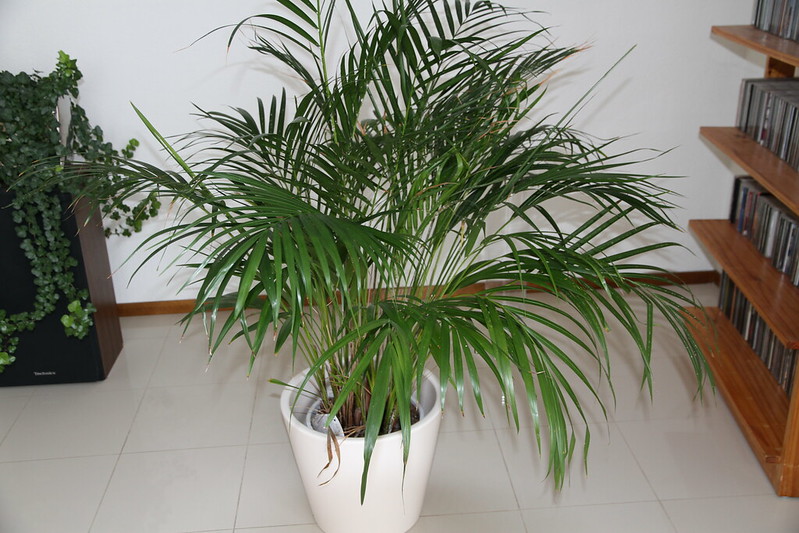Areca palm, scientific name Dypsis Lutescens, is a popular and highly sought-after houseplant known for its graceful appearance and ability to purify indoor air.
Also known as butterfly palm or golden cane palm, the areca palm adds a touch of tropical beauty to any space.
Areca palms are popular choices for homes and offices where they can be placed in living rooms, hallways, or lobbies.
Whether you’re a seasoned Areca Palm plant parent or a beginner looking to enhance your indoor garden, this comprehensive guide will provide you with the information you need to successfully grow and care for your areca palm.
What is Areca Palm
Imagine bringing a piece of the lush tropical rainforest into your home or office and enjoying the numerous benefits plants can offer improved air quality, reduced stress levels, and a renewed connection with nature.
The areca palm makes all of this possible. With its slender, arching fronds and golden-yellow stems, this palm species is a sight to behold. But its beauty is not the only reason why areca palms are so popular.
These plants are also excellent air purifiers, effectively removing harmful toxins from the surrounding environment.
So, let’s dive into the specifics of how to nurture and care for your areca palm to ensure it blooms and adds a touch of paradise areca palm to your indoor space.
| Category | Details |
|---|---|
| Scientific Classification | Kingdom: Plantae<br>Division: Tracheophyta<br>Class: Liliopsida<br>Order: Arecales<br>Family: Arecaceae<br>Genus: Dypsis<br>Species: D. lutescens |
| Common Names | Areca Palm, Butterfly Palm, Golden Cane Palm |
| Native Region | Madagascar |
| Mature Height | Up to 20 feet (6 meters) |
| Foliage | Feathery, arching fronds |
| Leaflets | Numerous, narrow, and green |
| Light Requirements | Bright, indirect light; can tolerate some shade |
| Temperature Range | 65°F to 75°F (18°C to 24°C) |
| Watering Needs | Keep soil consistently moist; avoid waterlogging |
| Soil Type | Well-draining, rich potting mix |
| Fertilization | Monthly during the growing season with a balanced fertilizer |
| Common Uses | Indoor decoration, landscaping, air purification |
| Toxicity | Generally non-toxic to humans and pets, but caution is advised |
| Maintenance | Moderate |
| Benefits | Air purification, humidity regulation, aesthetic appeal |
| Adaptability | Well-adapted to indoor environments; versatile landscaping plant |

Choosing the Right Location for Areca Palm
A crucial first step in successfully growing an areca palm is finding the perfect spot for it in your home. As native to Madagascar, these tropical plants require bright, indirect light to flourish.
Place your areca palm near a north- or east-facing window, where it can receive bright, filtered sunlight. Direct sunlight should be avoided, as it can scorch the delicate fronds.
Temperature and Humidity Requirements
Areca palms bloom in temperatures between 65°F and 75°F (18°C to 24°C). They can tolerate slightly lower temperatures during the night, but prolonged exposure to cold drafts should be avoided. To ensure optimal growth, maintain a consistent temperature range in your home.
In addition to temperature, areca palms also require high humidity levels. If the air in your home is dry, you can increase humidity by using a humidifier or placing the plant on a tray filled with water and pebbles.
Regularly misting the fronds with water can also help create the ideal humid environment for your areca palm.
Watering Your Areca Palm
Proper watering is crucial for the health of your areca palm. These plants prefer consistently moist soil, but overwatering can lead to root rot.
To strike the right balance, water your areca palm when the top inch of soil feels dry to the touch. Use room temperature water and ensure that excess water can drain freely from the pot. Avoid letting the plant sit in standing water, as this can lead to root damage.
It’s important to note that under-watering can cause the fronds to turn brown and dry. However, over time, if the underwatering persists, the plant may revert to a dormant state to conserve energy.
Staying attuned to your plant’s water needs and adjusting your watering routine accordingly is key to maintaining a healthy areca palm.
Fertilizing Routine
Regular fertilization is essential for promoting healthy growth and vibrant fronds in your areca palm. During the growing seasons of spring and summer, use a balanced liquid fertilizer with a ratio of 10-10-10 or 14-14-14 every two to four weeks.
Dilute the fertilizer according to the manufacturer’s instructions and apply it to moist soil, avoiding direct contact with the foliage. In the dormant seasons of fall and winter, reduce the frequency of fertilization to every two months.
Pruning and Maintenance
Pruning is an important aspect of caring for your areca palm. Regularly inspect your plant for any yellow or brown fronds and promptly remove them to maintain its aesthetic appeal.
Use clean and sharp pruning shears to make clean cuts at the base of the affected fronds. Avoid pruning healthy green fronds, as this can impede the plant’s ability to photosynthesize and generate energy.
In addition to pruning, dusting the leaves periodically with a soft, damp cloth or sponge can help remove any accumulated dust, allowing the palm to absorb sunlight more efficiently. Keeping the leaves clean also helps prevent pest infestations.
Dealing with Common Pests and Diseases
While areca palms are generally resilient, they may occasionally face some common pests and diseases. One of the most common pests affecting areca palms is spider mites.
These tiny pests can be identified by the fine webs they create on the foliage. To eliminate spider mites, thoroughly spray the plant with water, paying special attention to the undersides of the leaves.
If an infestation persists, consider using a mild insecticidal soap according to the manufacturer’s instructions.
Root rot is a potential disease that can affect areca palms if they are overwatered or exposed to excessively damp conditions.
To prevent root rot, ensure proper drainage by using well-draining soil and avoiding standing water in the pot. If root rot occurs, remove the affected areas and repot the plant in fresh, well-draining soil.

Propagation Techniques
Propagating areca palms can be done through division or by collecting and planting its seeds. Division involves carefully separating the offshoots or “pups” that grow at the base of the palm.
Carefully remove the pup from the main plant, ensuring it has its roots, and pot it in well-draining soil. Water it thoroughly and place it in a warm, humid location away from direct sunlight. With proper care, the pup will develop into a thriving areca palm.
Alternatively, if you wish to grow an areca palm from seeds, collect the ripe seeds from mature fruits and sow them in a well-draining potting mix.
Keep the soil consistently moist and maintain high humidity by covering the pot with plastic wrap or using a seedling tray with a transparent lid. Germination can take several weeks to months, so patience is key.
Top Five Benefits of Areca Palm
Air Purification: Areca palms are effective air purifiers, removing pollutants such as formaldehyde, benzene, and trichloroethylene from the air. This contributes to a healthy indoor environment and can enhance overall well-being.
Humidity Regulation: The transpiration process of areca palms releases moisture into the air, which helps control humidity levels. This is particularly beneficial in dry indoor environments, providing comfort to occupants and benefiting some houseplants.
Aesthetic Appeal: With its beautiful, feathery fronds and tropical appearance, the areca palm is prized for its aesthetic qualities. It adds a touch of greenery and sophistication to indoor spaces, making it a popular choice for home and office decor.
Versatility and Adaptability: Areca palms are versatile and can adapt to different light conditions. While they prefer bright, indirect light, they can tolerate lower light levels, making them suitable for a variety of indoor spaces. Their adaptability contributes to their popularity as houseplants.
Stress Reduction: Indoor plants, including areca palms, have been linked with reducing stress and improving mental health. The presence of greenery and caring for plants can have a positive effect on mood and stress levels, creating a more pleasant and peaceful environment.
Conclusion
Congratulations! You now have all the knowledge required to successfully grow and care for your very own areca palm.
Proper placement, temperature, humidity, and watering are the key elements to keep in mind. Don’t forget to fertilize your areca palm regularly and provide the occasional pruning and maintenance it needs.
By following these guidelines, your areca palm will flourish, adding a touch of natural elegance to your surroundings.
So, why wait? Bring home an areca palm and embark on a rewarding journey of plant nurturing, all while enjoying the beauty and health benefits this tropical wonder has to offer. Happy growing!
FAQs
Is Areca Palm a Good Indoor Plant?
Yes, the Areca Palm (Dypsis Lutescens) is an excellent indoor plant. It is prized for its graceful appearance, air-purifying qualities, and adaptability to indoor conditions.
Does Areca Palm Need Sunlight?
While the Areca Palm thrives in bright, indirect light, it can tolerate some shade. Placing it near a window with filtered sunlight is ideal for optimal growth.
Can Areca Palm Be Kept in the Bedroom?
Yes, Areca Palms can be kept in bedrooms. They not only add a touch of tropical beauty but also contribute to better air quality, making them a popular choice for indoor spaces, including bedrooms.
What Is Special About Areca Palm?
The Areca Palm is special for several reasons. Its feathery, arching fronds create an elegant tropical ambiance. It is known for its air-purifying capabilities, removing toxins from the air. Additionally, it is relatively low-maintenance and adds a refreshing touch to indoor decor.
